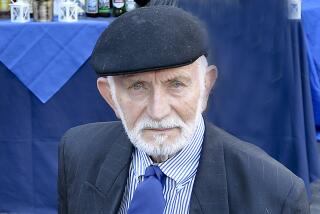John Spence dies at 95; Navy diver and pioneering WWII ‘frogman’
- Share via
John Spence, a diver often credited as the first U.S. combat “frogman” in World War II and an important figure in the rigorous training that led to the establishment of the Navy SEALs, has died.
Spence died Tuesday at a care facility in Bend, Ore. He was 95.
Because much of what Spence and others did during the war was under the Office of Strategic Services, the forerunner to the Central Intelligence Agency, stories of their bravery and resourcefulness were long classified as top secret.
Only in the late 1980s was the secrecy classification lifted, allowing Spence to finally tell friends and family members of his wartime experiences.
Rick Kaiser, executive director of the Navy SEAL Museum at Fort Pierce, Fla., said that Spence “fought for our country with nothing more than a Ka-Bar knife, a pack of explosives and a diving rig.”
“In today’s age of drone strikes and worldwide instant communications,” Kaiser said, “it’s hard to imagine going to war depending on nothing but your training, your cause and your teammates.”
John Pitts Spence was born June 14, 1918, in Centerville Tenn., where his father was the sheriff. He joined the Navy in 1936 and was trained as a gunner and “hard-hat” diver.
He served on the battleship Idaho, whose home port was San Pedro, left the Navy in 1940 and worked for Lockheed in Los Angeles County. He moved to rejoin the military after the Japanese attack on Pearl Harbor.
Although he wanted to deploy as a gunner protecting merchant ships, Spence had the kind of diving experience that made him a natural for a clandestine group being organized by the OSS under the legendary Major Gen. William “Wild Bill” Donovan.
Spence became the first enlisted man selected for the group, which was trained in stealth, demolition and close-in combat tactics, with the goal of sinking enemy ships and also blowing up underwater emplacements meant to thwart beach landings by U.S. assault troops.
During the training phrase, a new word was coined, based on the green waterproof suit that Spence was wearing.
“Someone saw me surfacing one day and yelled out, ‘Hey, frogman!’ The name stuck for all of us,” Spence told maritime historian and filmmaker Erick Simmel.
In the initial training, Spence met a medical school student named Chris Lambertsen, who had developed a breathing apparatus that Spence was ordered to test. The device sent no bubbles to the surface, which would help swimmers approach their target without notice.
“The only sound was my own breathing,” Spence told Simmel. “It made me feel kind of like Buck Rogers. Its classification was … on a par with the atomic program.”
Lambertsen’s breathing device, which he built in his garage, became the prototype for the apparatus still used by SEALs and other Special Forces troops.
Sent to England, Spence’s unit prepared for a mission to attack a German submarine base on the French coast. But to Spence’s dismay, the mission was scrubbed at the last moment for fear it would tip the Germans that the D-Day landings at Normandy were in preparation.
Spence made several forays into occupied France with British commandos, linking up with the French underground and rescuing downed airmen. Later he was assigned to a training command in the Bahamas as a scuba instructor preparing combat swimmers to support the war against Japan.
During the “island-hopping” campaign in the Pacific, Spence deployed aboard the destroyer Wadsworth. He manned a forward gun battery to provide covering fire for combat swimmers during the assault on Iwo Jima. During the prolonged battle for Okinawa, he fought off Japanese kamikaze planes in a battle described by historians as pitting “gunners who wanted to live against pilots who wanted to die.”
After the war, Spence remained in the Navy until retiring in 1961 as a master chief gunner’s mate. The first SEAL teams were organized in 1962 – one in Coronado, one in Virginia – with the enthusiastic support of President John F. Kennedy.
After leaving the Navy, Spence returned to Lockheed Corp. as a systems testing engineer. He lived in the San Fernando Valley and then in Oroville in Northern California. After the death of his second wife, Spence moved to Bend, Ore.
Once the veil of secrecy was lifted, Spence was honored by the Army Special Forces and the Underwater Demolition Team SEAL Assn. He received a green beret from the Army and, from the Navy, a Trident, the insignia worn by SEALs. He was honored at the Naval Academy.
Spence’s third wife, Marilyn, died in 2002. He is survived by daughters Genevieve Ross, Yvonne Romano, Margot Kirkwood and Sharon Ogden, and several grandchildren and great-grandchildren.
More to Read
Start your day right
Sign up for Essential California for the L.A. Times biggest news, features and recommendations in your inbox six days a week.
You may occasionally receive promotional content from the Los Angeles Times.







